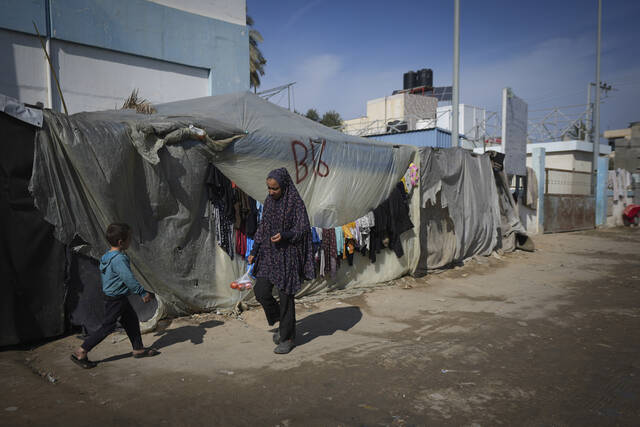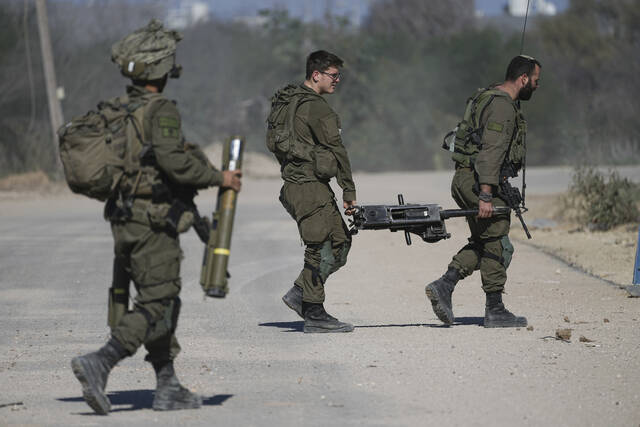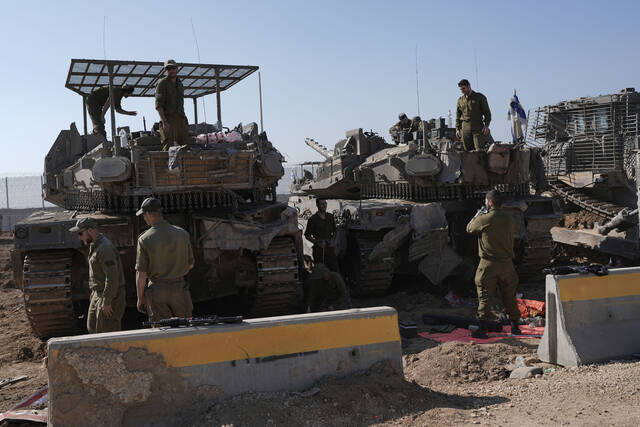Ceasefire between Israel and Hamas will go into effect Sunday morning, officials say
CAIRO — The ceasefire between Hamas and Israel will go into effect at 8:30 a.m. local time Sunday (1:30 a.m. EST), mediator Qatar announced Saturday, as families of hostages held in Gaza braced for news of loved ones, Palestinians prepared to receive freed detainees and humanitarian groups rushed to set up a surge of aid.
The overnight approval of the deal by Israel’s Cabinet, in a rare meeting during the Jewish Sabbath, set off a flurry of activity and a fresh wave of emotions as relatives wondered whether hostages would be returned alive or dead. The names of the first hostages to be freed were expected to be released later Saturday.
The pause in 15 months of war is a step toward ending the deadliest, most destructive fighting ever between Israel and the Hamas militant group — and comes more than a year after the only other ceasefire achieved.
The first phase of the ceasefire will last 42 days, and negotiations on the far more difficult second phase are meant to begin just over two weeks in. After those six weeks, Israel’s security Cabinet will decide how to proceed.
Israeli airstrikes continued Saturday, and Gaza’s Health Ministry said 23 bodies had been brought to hospitals over the past 24 hours.
“What is this truce that kills us hours before it begins?” asked Abdallah Al-Aqad, the brother of a woman killed by an airstrike in the southern city of Khan Younis. Health officials said a couple and their two children, aged 2 and 7, were dead.
And sirens sounded across central and southern Israel, with the military saying it intercepted projectiles launched from Yemen. Iran-backed Houthi rebels there have stepped up attacks in recent weeks, calling it solidarity with Palestinians in Gaza.
In a post on X, Qatar’s foreign minister advised Palestinians and others to exercise caution when the ceasefire goes into effect and wait for directions from officials.
“The first thing I will do is go and check my house,” said Mohamed Mahdi, a father of two who was displaced from Gaza City’s Zaytoun neighborhood. He also looks forward to seeing family in southern Gaza, but is “still concerned that one of us could be martyred before we are able to meet.”
In the ceasefire’s first phase, 33 hostages in Gaza are set to be released over six weeks in exchange for 737 Palestinian prisoners held by Israel. Israel’s justice ministry has published a list of the prisoners, all younger or female.
According to the ceasefire plan approved by Israel’s Cabinet, the exchange will begin at 4 p.m. local time Sunday. The plan says three living female hostages will be returned on Day 1, four on Day 7 and the remaining 26 over the following five weeks. During each exchange, Palestinian prisoners will be released by Israel after hostages have arrived safely.
Also to be released are 1,167 Gaza residents who were not involved in the Oct. 7, 2023, Hamas-led attack that sparked the war. All women and children under 19 from Gaza held by Israel will be freed during this phase.
All Palestinian prisoners who were convicted of deadly attacks will be exiled to Gaza or abroad — some for three years and others permanently — and barred from returning to Israel or the West Bank.
The remaining hostages in Gaza, including male soldiers, are to be released in a second phase to be negotiated during the first. Hamas has said it will not release the remaining captives without a lasting ceasefire and a full Israeli withdrawal.
Also during the ceasefire’s first phase, Israeli troops are to pull back into a buffer zone about 0.6 miles wide inside Gaza, along its borders with Israel.
That will allow many displaced Palestinians to return to their homes, including in Gaza City and largely isolated and devastated northern Gaza. With most of Gaza’s population sheltering in massive, squalid tent camps, Palestinians are desperate to get back to their homes, even though many were destroyed or heavily damaged.
Gaza should also see a surge in food, medical supplies and other humanitarian aid. Trucks were lined up Friday on the Egyptian side of the Rafah border crossing into Gaza.
On Saturday, two Egyptian government ministers arrived in the northern Sinai Peninsula to oversee preparations for delivering aid through the Rafah crossing as well as the Kerem Shalom crossing, and to receive the evacuation of wounded patients, Egypt’s health ministry said.
The ceasefire plan approved by Israel’s Cabinet says all trucks entering Gaza will be subject to Israeli inspections.
The Hamas-led Oct. 7 attack killed some 1,200 people and left some 250 others captive. Nearly 100 hostages remain in Gaza.
Israel responded with an offensive that has killed more than 46,000 Palestinians, according to local health officials, who do not distinguish between civilians and militants but say women and children make up more than half the dead.
Early Saturday morning, Israel’s Cabinet approved the deal for a ceasefire in Gaza that would release dozens of hostages and pause the 15-month war with Hamas, bringing the sides a step closer to ending their deadliest and most destructive fighting ever.
Despite the ceasefire news, sirens sounded across central Israel on Saturday, with the army saying it intercepted projectiles launched from Yemen. The Iran-backed Houthis have stepped up their missile attacks, in recent weeks. The group says the attacks are part of their campaign aimed at pressuring Israel and the West over the war in Gaza.
There were also continued Israeli strikes into Gaza. The Palestinian Health Ministry said at least 23 people were killed in the previous day.
Under the first phase of the ceasefire, 33 hostages are set to be released over the next six weeks, in exchange for hundreds of Palestinians imprisoned by Israel. The remainder, including male soldiers, are to be released in a second phase that will be negotiated during the first. Hamas has said it will not release the remaining captives without a lasting ceasefire and a full Israeli withdrawal.
According to the ceasefire plan, approved by the Cabinet and signed by Israel’s national security adviser, the exchange will begin at 4 p.m. local time Sunday. During each exchange, prisoners will be released by Israel after the hostages have arrived safely.
The plan says that during phase one, some 1,900 Palestinian prisoners will be released, in exchange for 33 Israeli hostages, both alive and dead. Among the prisoners, 1,167 are residents in Gaza who were held by Israel but were not involved in Oct. 7. All women and children under 19 from Gaza held by Israel will be freed during this phase.
All Palestinian prisoners who were convicted of deadly attacks will be exiled, either to Gaza or abroad, and barred from returning to Israel or the West Bank. Some will be exiled for three years and others permanently, according to the plan.
Key questions remain about the ceasefire, however — the second achieved during the war — including the names of the 33 hostages who are to be released and who among them is still alive.
Hamas has agreed to free three female hostages on Day 1 of the deal, four on Day 7 and the remaining 26 over the following five weeks.
Palestinian detainees are to be released as well. Israel’s justice ministry published a list of more than 700 who are to be freed in the deal’s first phase and said the release will not begin before 4 p.m. local time Sunday. All people on the list are younger or female.
Also during the first phase, Israeli troops are to pull back into a buffer zone about 0.6 miles wide inside Gaza, along its borders with Israel.
That will allow displaced Palestinians to return to their homes, including in Gaza City and northern Gaza. With most of Gaza’s population driven into massive, squalid tent camps, Palestinians are desperate to get back to their homes, even though many were destroyed or heavily damaged by Israel’s campaign.
The largely devastated territory should also see a surge in humanitarian aid. Trucks carrying aid lined up Friday on the Egyptian side of the Rafah border crossing into Gaza. On Saturday, two Egyptian government ministers arrived in the northern Sinai Peninsula to oversee the preparations for the delivery of aid and to receive the evacuation of wounded patients, the health ministry said.
Hamas triggered the war with its Oct. 7, 2023, cross-border attack into Israel that killed some 1,200 people and left some 250 others captive. Nearly 100 hostages remain in Gaza.
Israel responded with a devastating offensive that has killed more than 46,000 Palestinians, according to local health officials, who do not distinguish between civilians and militants but say women and children make up more than half the dead.
Remove the ads from your TribLIVE reading experience but still support the journalists who create the content with TribLIVE Ad-Free.



